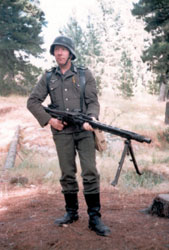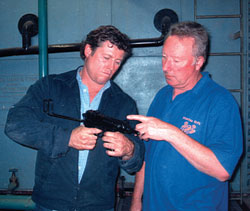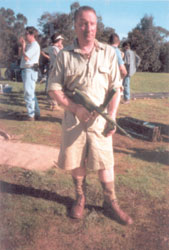Arming the film industry - John Bromley
by Yolanda Corduff
Australian Shooter June 2004
From Division Four to Blue Heelers, Aussie police dramas have made ‘must-see’ TV for years. And what’s a decent police drama without the odd shoot-out, a chance for the crims to get their ‘just desserts’ and the coppers to show off some of the hardware they’re famous for carrying. But with Australia’s strict gun laws, you have to wonder where our local filmmakers get their guns? Why, your friendly, local armourer, of course.
 You probably haven’t heard the name John Bromley before. Or maybe you have, if you’re the kind of person who reads the credits at the end of your favourite TV show or movie and pays particular attention to the title ‘Armourer’.
You probably haven’t heard the name John Bromley before. Or maybe you have, if you’re the kind of person who reads the credits at the end of your favourite TV show or movie and pays particular attention to the title ‘Armourer’.
But more than likely, you’ve seen Bromley on the screen, or at least his big strong hands cradling a shiny handgun in a nice close-up - with a round or two being fired off.
As one of Australia’s leading film and television armourers, Bromley’s famous hands have been on most Aussie TV dramas, from early Crawford Productions like Division Four and Homicide to Channel Nine’s Stingers, Channel Seven’s Blue Heelers and ABC TV’s Sea Change.
Bromley’s also done his fair share of cinema-release movies, most recently working on the Australian films Bad Eggs and The Wannabees, as well as overseas productions, including a few Jackie Chan flicks.
“I’ve often found myself in scenes, using the firearms instead of the actors because the director needed a more authentic look and I was the only one there who could pull it off,” says Bromley, 63, kicking back in his Melbourne home. “They also use my hands a lot, for close-ups with firearms, especially if the gun has to be shot pretty close to a camera and the person doing the scene hasn’t got the knowledge and skills to do it.
“If the actors haven’t handled guns much before, it can be a tricky shot to get right and they might damage the camera and the people behind it. Often, in that kind of close-up, the gun has to be shot in a certain direction every time so I regularly do those sorts of shots. My hands are probably more famous than I am,” he adds with a smile.
A gun enthusiast from early on, Bromley owned his first air rifle at age nine and, at around 13 years of age, he joined his local rifle club where he honed his shooting skills on small bore. It wasn’t long before he got into heavy calibres, like .303s, and began competition shooting, something he continues to do to this day.
It was also around this time that Bromley, who is also a long-standing member of the SSAA, began collecting firearms and, after a stint in the army, he got himself a gun dealer’s licence so he could be more involved in firearms.
Luckily for Bromley, he was able to get most of his firearms when gun laws were more lenient and the market much cheaper.
“Years ago, an armourer could order a Sten gun for about 30 pounds each,” he said, noting that nowadays, even if you can get those types of guns into the country, they’d probably cost you about $5000 each and be welded up and inert to meet legal requirements, making them useless to the armourer.
While Bromley accumulated a decent collection of firearms, he never planned to become an armourer in the film industry. A friend, who was working at Crawford’s and knew about his gun collection, asked if he could help out by providing some firearms for a TV show they were filming. The shoot worked out so well that Bromley, who by then was a qualified butcher, was soon invited back to help with other film and television projects.
“I’ve never advertised nor had an agent. I’m not even in the phone book. All the work I’ve received has been from word-of-mouth,” he says, adding that he kept up his work at the butchery until the demands of his armoury work took over. “Eventually I just sold up and got into the film work more or less full-time. I had the firearms to do it and I figured I could always go back to being a butcher if I fell flat on my face.”
 Bromley never went back to being a butcher. Instead, he embarked on a career that has lasted for more than 20 years, turning his beloved hobby into an income that not only pays the bills but has also allowed him to indulge his love of firearms, by amassing a collection of guns that any Australian museum would be proud to own.
Bromley never went back to being a butcher. Instead, he embarked on a career that has lasted for more than 20 years, turning his beloved hobby into an income that not only pays the bills but has also allowed him to indulge his love of firearms, by amassing a collection of guns that any Australian museum would be proud to own.
“The best things about my career as an armourer are been meeting people and getting paid to do something I love,” he boasts. “Shooting is my sport, so getting paid for participating in my sport is great. And it’s given me reason to add more firearms to my collection.”
While being an armourer has been a lot of fun, Bromley reminds us that it’s still work and it does have its ups and downs.
“I’ve always said if there was a two-week TAFE course on being an armourer, the first week they’d teach you how to handle and identify firearms and the second week they’d teach you how to sit around and do nothing,” he says, adding that even if you spend a lot of time waiting around for the firearms to be needed, the days are still long - usually 12 to 16 hours, with a 7.30am start. “You’ll sit there and twiddle your thumbs for hours then the director will shout, ‘Quick, gun man, gun man, we want this, we want that,’ and you’ve just got to have it there, ready, because when they need you on set, they need you at that moment and ready for action.”
Bromley also puts in many hours away from the set, training actors at the approved range, showing them how to handle and shoot firearms. If the actors involved are playing police officers, Bromley teaches them to handle the guns just like a real policeman would. If the actor’s playing a bad guy or a gangster, then he shows them how to handle the guns like a gangster.
“The actors are very appreciative and great to work with,” says Bromley, admitting that the women are just as keen and interested as the men are in learning to use firearms safely, even if the women have less hand strength and find the heavy triggers more difficult to pull. “When I’m teaching the actors, their eyes just boggle. At the range, I let the actors fire some rounds, so they can get used to the guns they’ll be using on set. Generally, they’ve never fired guns before so they really pay attention.”
Bromley has also taught experienced shooters and says they’re sometimes more difficult to teach, “because they already know so much”. Meanwhile, the actors, who haven’t fired guns before, tend to be extremely interested and very, very careful - taking everything in.
While training is a big part of the job, mostly the armourer on set is responsible for safety.
“It’s the thing you most have to watch, which sometimes means having eyes in the back of your head,” explains Bromley. “When the guns are firing, you’re responsible for everybody’s safety on the set, the actors and the crew. Sometimes the director will want guns firing directly at the camera, so you’ve got to supervise all that to make sure everyone’s safe and far enough away.
“That’s when you’re brain starts boggling, especially when you’ve got a lot of people on set. One big film I worked on, we had 50 actors playing Partisans and about 100 playing Germans, all running into each other and firing. Of course for something that big you need more than one armourer. On that film I think we had about five on the set, in different areas, just watching and putting the best person forward and just checking on everything all the time.”
But Bromley doesn’t just deal with safety issues, he’s a firearms specialist after all and his expertise is often called upon to identify what kinds of guns the various characters would use, not to mention supplying the firearms and training.
 “Mostly my decisions about what guns to use will depend entirely on the scripts and the characters. I get the scripts ahead of time and I sort out who the firearms are supposed to go to, like to the bad guys or the good guys,” says Bromley. “Depending on the character and the circumstances, I’ll pick the most appropriate firearm for them. I’ve got everything I need to supply and all that so I just read the scripts, work out what’s needed then talk to the director and say, ‘Well this guy here’s a top drug dealer and drives a Mercedes Benz, so he’d have something nice and modern if he’s going to pull a gun out’. I’ll give him something nice and shiny, which looks pretty fascinating. Or if the character’s a bit of a down-and-out kind of guy, someone who’s sleazy and acquired his gun ‘under the counter’, I’ll give him a rusty old thing.”
“Mostly my decisions about what guns to use will depend entirely on the scripts and the characters. I get the scripts ahead of time and I sort out who the firearms are supposed to go to, like to the bad guys or the good guys,” says Bromley. “Depending on the character and the circumstances, I’ll pick the most appropriate firearm for them. I’ve got everything I need to supply and all that so I just read the scripts, work out what’s needed then talk to the director and say, ‘Well this guy here’s a top drug dealer and drives a Mercedes Benz, so he’d have something nice and modern if he’s going to pull a gun out’. I’ll give him something nice and shiny, which looks pretty fascinating. Or if the character’s a bit of a down-and-out kind of guy, someone who’s sleazy and acquired his gun ‘under the counter’, I’ll give him a rusty old thing.”
While it’s important to have the right firearm for the kind of story being told, Bromley also spends quite a bit of time ensuring continuity.
“You can’t have guys running around with one kind of gun in a long shot then on a close-up, which might be filmed the next day, have the same characters holding different firearms. So continuity is very important,” he says.
The armourer also spends a lot of time dealing with the Police Film and Television Office, ensuring all the required paperwork has been completed and the police have been properly informed. The police need to know what guns are going to be fired, even if imitation guns are being used, and whether the film shoot will be out in the open or in public. This avoids unnecessary call-outs that can result when someone doesn’t realise it’s a ‘staged’ shoot-out and calls the police.
During the years, Bromley’s seen a lot of changes in the film armoury trade, from harsher gun laws to tighter film budgets and digitally enhanced firepower. While he thinks that some of the legal changes have been for the better, he points to the 1996 gun laws as the main reason new armourers aren’t getting into the business.
“They changed the [gun] legislation back in 1996 so now, if you need anything from overseas, you need a letter from the film company explaining why you need the guns and a letter from the Attorney-General so Customs will let them through,” he says, adding that all the guns have to be destroyed or sent back out of the country at the end of filming.
“Before, we could just bring in the firearms required, use them and leave them in stock. You can end up spending $20,000 or $30,000 on guns, bringing them into the country, and you might only get $200 return from them on the one film, as far as hiring goes - not counting my wages. That didn’t really matter before because I could keep the firearms and use them again and again, till they paid for themselves. Now I’ve got to get rid of the guns,” he says, adding that the new system is just ridiculous. “I mean, I’m allowed to keep the hundreds of firearms I’ve got now but not allowed to add one more to my collection.”
Consequently, Bromley sees the armoury game as a dying trade, because to do the job you need to have plenty of money and/or plenty of guns, along with the expertise and knowledge - as well as the correct licensing in place.
So how will the film and television industry deal with the lack of armourers in the future? “I think it’s all going to be digital special effects, done on computers,” suggests Bromley. “All they’ll need is the actor’s face and they’ll just animate everything else around him, even the guns. So, you won’t need armourers, they’ll just use ‘virtual’ firearms.”
